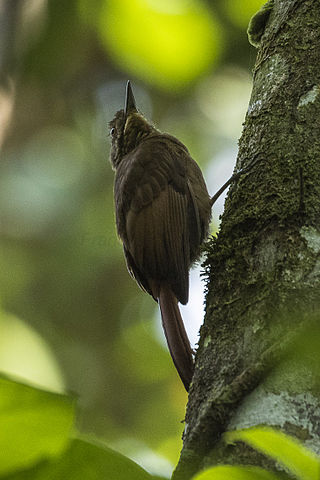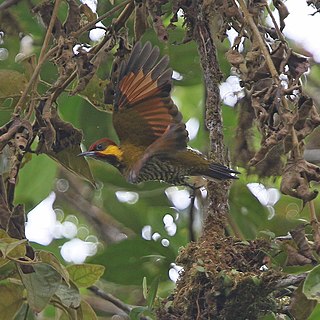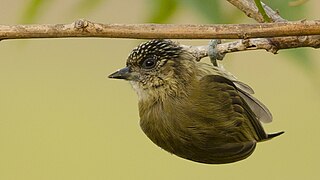
The red-crowned woodpecker is a species of bird in the subfamily Picinae of the woodpecker family Picidae. It is found in Costa Rica, Panama, Colombia, Venezuela, Guyana, Suriname, and Tobago.

The cocoa woodcreeper is a species of bird in the subfamily Dendrocolaptinae of the ovenbird family Furnariidae. It is found in Colombia, Costa Rica, Guatemala, Honduras, Nicaragua, Panama, Trinidad and Tobago, and Venezuela.

The plain xenops is a passerine bird in the Furnariinae subfamily of the ovenbird family Furnariidae. It is found in the tropical New World from southern Mexico south as far as northern Bolivia and east across Brazil.

The dot-winged antwren or velvety antwren is a passerine bird in subfamily Thamnophilinae of family Thamnophilidae, the "typical antbirds". It is found in Mexico, every Central American country except El Salvador, Bolivia, Brazil, Colombia, Ecuador, French Guiana, Guyana, Peru, and Suriname.

The stripe-cheeked woodpecker is a species of bird in subfamily Picinae of the woodpecker family Picidae. It is endemic to Panama.

The black-crested coquette is a species of hummingbird in the "coquettes", tribe Lesbiini of subfamily Lesbiinae. It is found in Belize, Costa Rica, Guatemala, Honduras, Mexico, and Nicaragua.

The tawny-winged woodcreeper is a passerine bird in subfamily Dendrocolaptinae of the ovenbird family Furnariidae. It is found in Belize, Costa Rica, Guatemala, Honduras, Mexico, Nicaragua, and Panama.

The slender-billed xenops is a species of bird in the Furnariinae subfamily of the ovenbird family Furnariidae. It is found in Bolivia, Brazil, Colombia, Ecuador, French Guiana, Guyana, Peru, Suriname, and Venezuela.

The ivory-billed woodcreeper is a species of bird in the subfamily Dendrocolaptinae of the ovenbird family Furnariidae. It is found in Belize, Costa Rica, El Salvador, Guatemala, Honduras, Mexico, and Nicaragua.

The black-striped woodcreeper is a species of bird in the subfamily Dendrocolaptinae of the ovenbird family Furnariidae. It is found in Colombia, Costa Rica, Ecuador, Nicaragua, and Panama.

The chestnut-colored woodpecker is a species of bird in subfamily Picinae of the woodpecker family Picidae. It is found in Belize, Costa Rica, Guatemala, Honduras, Mexico, Nicaragua, and Panama.

The cinnamon woodpecker is a species of bird in subfamily Picinae of the woodpecker family Picidae. It is found in Colombia, Costa Rica, Ecuador, Nicaragua, and Panama.

The rufous-headed woodpecker is a species of bird in subfamily Picinae of the woodpecker family Picidae. It is found in Bolivia, Brazil, Ecuador, and Peru.

The waved woodpecker is a species of bird in subfamily Picinae of the woodpecker family Picidae. It is found in Bolivia, Brazil, Colombia, Ecuador, French Guiana, Guyana, Peru, Suriname, and Venezuela.

The yellow-browed woodpecker, also known as the white-browed woodpecker, is a Near Threatened species of bird in the woodpecker family Picidae. It is found in Argentina, Brazil, Paraguay, and Uruguay.

The white-throated woodpecker is a species of bird in subfamily Picinae of the woodpecker family Picidae. It is found Bolivia, Brazil, Colombia, Ecuador, and Peru.

The Lita woodpecker is a species of bird in subfamily Picinae of the woodpecker family Picidae. It is found in Colombia and Ecuador.

The rusty-necked piculet is a species of bird in subfamily Picumninae of the woodpecker family Picidae. It is found along the Brazilian-Bolivian border.

The olivaceous piculet is a species of bird in subfamily Picumninae of the woodpecker family Picidae. It is found from Guatemala south through Central America and western South America to Peru.

The rufous-breasted piculet is a species of bird in subfamily Picumninae of the woodpecker family Picidae. It is found in Bolivia, Brazil, Colombia, Ecuador, and Peru.























